X-ray fish are some of the more unique types of tetra fish out there. While there are thousands of species, only a few dozen are seen with any frequency in the hobby. And the X-ray tetra might be one of the rarer of them.
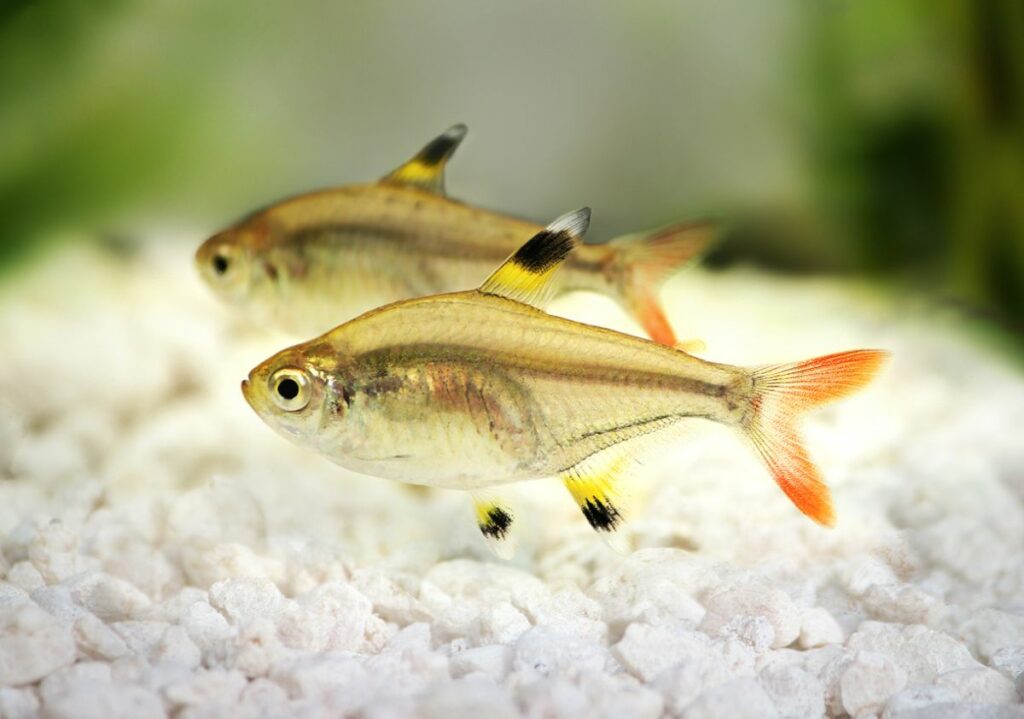
Why this is we aren’t sure because they are also some of the most unique in appearance. With their translucent bodies and eye-catching fins, pristella tetras can find a place in nearly any aquarium setup. So what are these intriguing little fish anyway and how can we care for them?
What are X-Ray Fish?
One look and it is easy to see how x-ray tetras get their name. These tetras aren’t quite as see-through as glass catfish but they are still very interesting. Their silvery body is opaque around their bellies but their backs and tails can be almost entirely transparent. When young they are even more see-through.
This ability is likely a defense against predators. It is almost impossible to track a small, fast-moving fish that happens to also be see-through in the dark waters of the Amazon. And couple that with its preference for living in large schools and you have a recipe for safety that is hard to beat.
X-ray tetras also have distinctive markings on their dorsal, anal, and pectoral fins, as well as vibrant red tails. These markings help the tetras remain in a school and group as one when moving through the blackwater environments they favor.
X-ray fish are also sold as pristella tetras, which is their scientific genus. Pristella used to be a group with just one species but a couple of other closely related tetras have been discovered and described in recent years.
That said, Pristella maxillaris is the only species that you will find in the aquarium hobby. They are captive bred in large numbers these days, enough that you occasionally find pristella tetra for sale even in major stores like Petsmart and Petco.
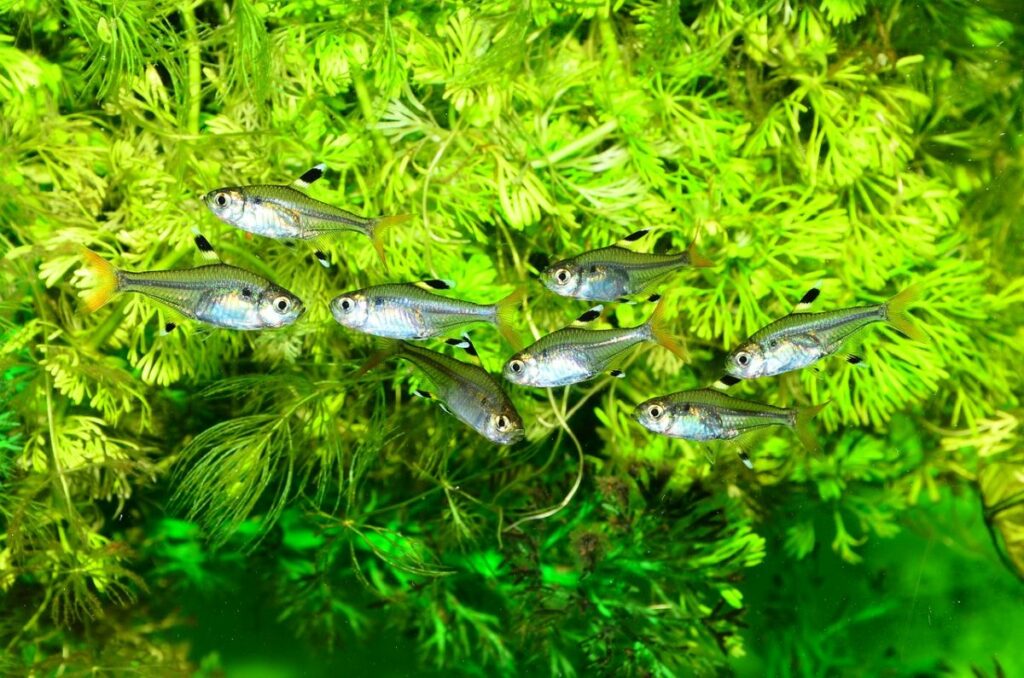
Albino and Gold Pristella Tetra
Many color morphs are also becoming more widely available. These include the albino pristella tetra and golden pristella tetra. Both varieties will interbreed with regular x-ray tetras and can be kept alongside their normal colored cousins. Their care requirements are also the same and they are just as hardy as any other fish.
- Common Names: X Ray Fish, X Ray Tetra, Pristella Tetra
- Scientific Name: Pristella maxillaris
- Origin: Amazon and Orinoco River basins, coastal streams the Guianas
- Aquarium Size: 10+ Gallons
- Length: 2 inches
- Temperament: Peaceful; Schooling
- Ease of Care: Easy
Pristella Tetra Care
Most tetras are a little on the sensitive side. But x-ray fish tend to be a little more durable and are a good choice for beginners to tetra fish care.
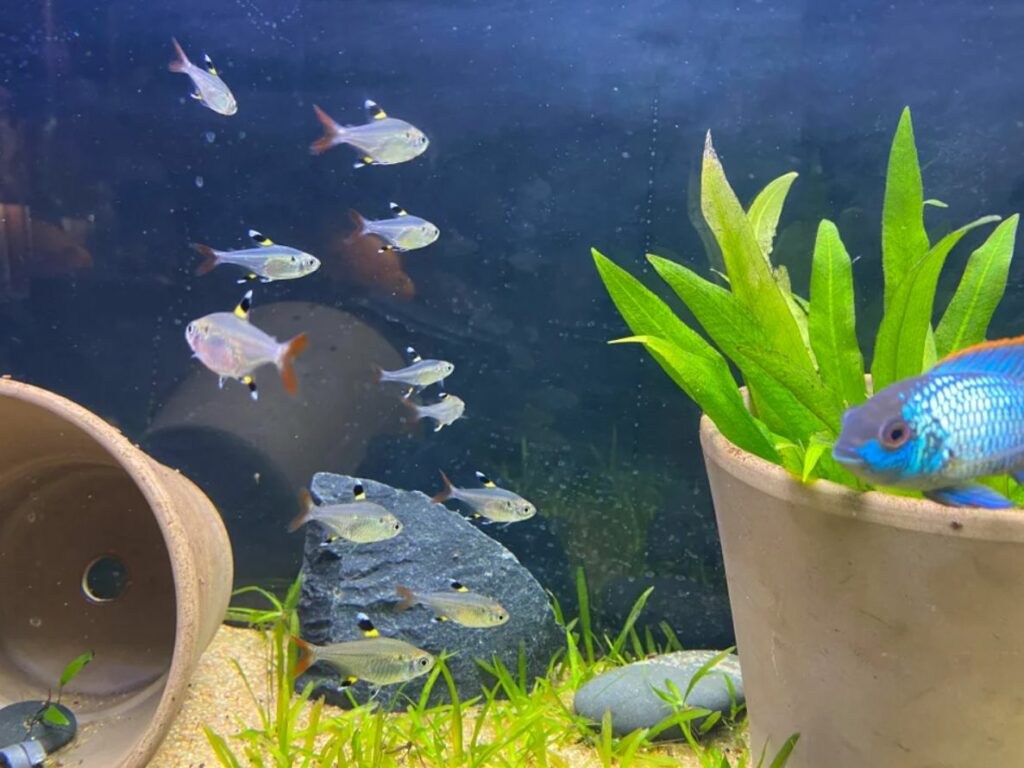
Pristella Tetra Size
Pristella tetra fish are on the small side as they only reach around 2 inches in length when full grown. This makes them suitable for aquariums as small as 10 gallons in volume. That said, I would recommend a slightly larger tank since they are schooling fish and should be kept in groups no smaller than 6 individuals.
Once you have your gold pristella tetras you won’t have much room for anything else in a 10 gallon fish tank. A 20 gallon long offers not much more water volume but also more space to swim, which these active fish do need.
Pristella Tetra Fish and Plants
I highly recommend keeping live plants alongside x-ray tetras. Plants enjoy the same conditions that these fish do and offer a whole host of benefits. They filter out ammonia and other nitrogenous waste products, using them as fertilizer for their own growth. They absorb carbon dioxide and release oxygen for your fish to breathe. And plants provide a ready place for egg scattering fish like x-ray pristella tetras to spawn in.
These tetras also don’t eat or uproot plants. They are entirely plant safe and the dark green shade of a heavily planted tank will make them more active and willing to swim out in the open.
Water Conditions for X-Ray Tetras
Another reason why the tetra pristella is so popular is because they are hardier than most tetra fish. Tetras as a group tend to be a little sensitive, requiring little water hardness and soft, acidic water conditions (pH <7.0).
They also are somewhat sensitive to elevated levels of ammonia, nitrite, and nitrate. Minerals and nitrogenous waste products tend to shorten their lifespans or even kill them outright, especially if they are wild caught fish, as most cardinal tetras and other popular tetra fish are.
But pristella tetra fish are all captive raised and are acclimated to neutral to hard water conditions. If you can adjust the pH closer to neutral or even slightly acidic they will thank you for it but it isn’t necessary.
They are also a little hardier than most when it comes to ammonia and other fish waste products. That does not mean you should be slack about water changes and filter maintenance; they are still tetras and will suffer if the water conditions become too poor.
Interestingly enough, x-ray pristella tetras also tolerate salt somewhat well for tetra fish, which are very intolerant of any salt in their water. These tetras are often found in coastal streams where the water can approach brackish environmental levels of salt content. Brackish environments are waters where salt from the ocean meets freshwater from land.
That said, pristella tetras are not true brackish water fish. They tolerate low levels of salt but don’t need it and don’t do well with extended brackish living. So keep your x-ray fish in freshwater with at most a touch of aquarium salt.
As natives of the South American continent, golden pristella tetra fish need warm conditions since they live close to the equator. Temperatures of 75-82℉ are perfect for them. And if you are looking to try breeding pristella tetras then you may want to temporarily raise the temperature to 82-85℉ to stimulate them.
Pristella Tetra Tank Mates
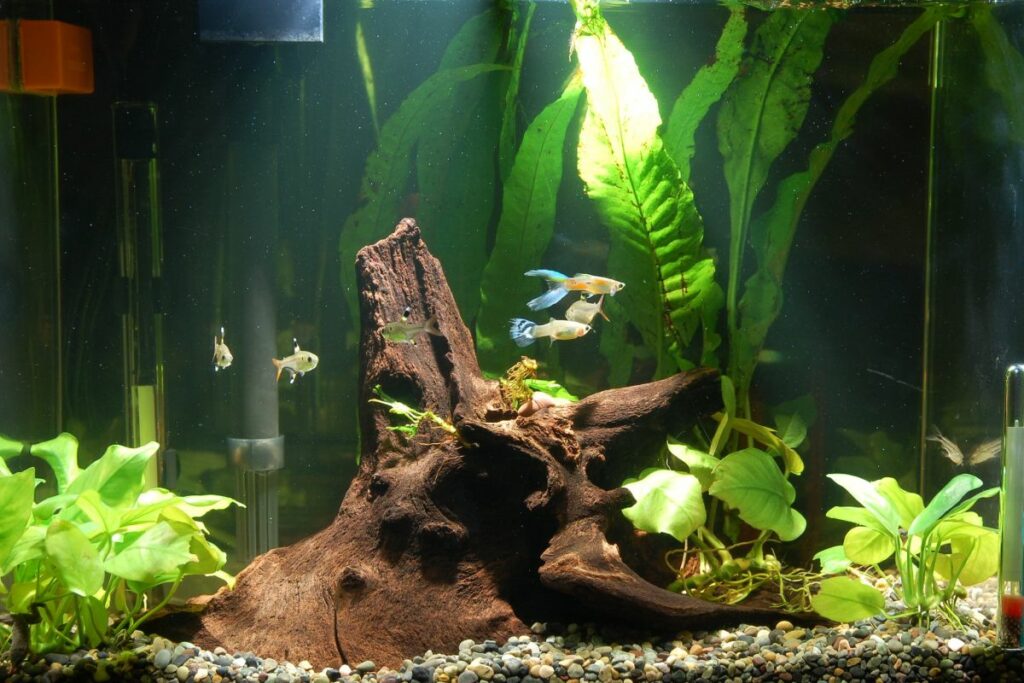
Choosing pristella tetra tank mates is not too difficult to do because these fish are mostly peaceful and get along with a very large range of fish. Most common community aquarium fish will do well with them. What’s more important is choosing fish that won’t grow large enough to bully or eat these small tetras.
Angelfish are a poor choice for this reason. While they are beautiful and can live with pristella tetras when young, once they grow up they may be large enough to eat them.
Common tank mate choices for x-ray fish include honey gouramis, zebra danios, guppies, apistogramma cichlids, and hatchetfish. You can also keep them with other tetra fish; just make sure that you have room for multiple schools of fish since all tetras love their own company and need to school together.
Bottom dwelling fish that are peaceful and on the small side also live well alongside x-ray tetras. Corydoras are a solid choice as they also happen to be Amazonian natives that enjoy the same water conditions. Dwarf otocinclus may not be as cute and active but they are tiny algae eating fish that also do great and come from the Amazon just like pristella tetra fish.
Larger bottom dwellers like plecostomus (sucker fish) should be avoided. Even if they are vegetarians these fish grow much too large for tetras to feel safe alongside them for long.
Are Pristella Tetras Fin Nippers?
Sometimes the x-ray tetra can be a fin nipper. They find slow moving fish with long fins that wave and wag in the current to be very tempting. Betta fish can be poor tank mates for this reason; their fins and slow moving ways make them too easy a target. Short-finned varieties like the alien betta don’t have this problem and are great choices to keep with tetra fish.
Long finned goldfish will suffer for the same reason, though you should not be keeping goldfish with tetras anyway – they have very different needs in terms of water conditions.
The best way to avoid fin nipping behavior is to keep pristella tetras in groups of 6 or more fish. Tetras are nippy fish in general but focus all of their attention on each other if given the chance. It’s small groups or lone tetras that usually turn into fin nippers.
What do Pristella Tetra Fish Eat?
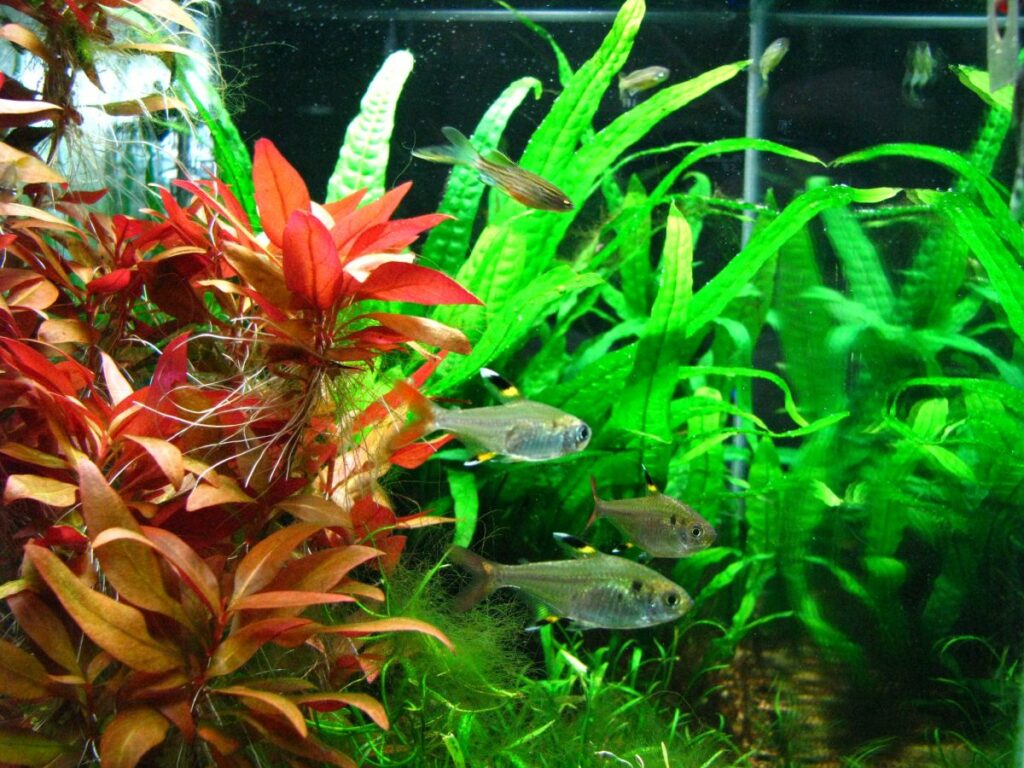
X-ray fish are micro predators, meaning they feed on small aquatic life that they find in nature. This means that they hunt for small worms, insect larvae, fish fry and eggs, plankton, and anything else tiny and moving that can be eaten.
Therefore we want a high protein diet that contains little to no vegetable matter since these fish don’t eat algae or plants. When shopping for tetra fish food I am on the lookout for high quality ingredients like krill, whole salmon, black soldier fly larvae, and so on. Don’t go for brands that use fillers like wheat, potato starch, soy, and so on…It is not very good for pristella tetras.
Any prepared food formula should also be easy to eat. Flakes will soften in contact with the water but if you can break up larger chunks a little, it will help. Pellets should also be micropellets small enough for their tiny mouths.
Once you have your animal-rich prepared food blend, supplement it with a selection of live and frozen foods. Brine shrimp, daphnia, tubifex worms, and bloodworms will all be greedily eaten by these fish. If you’re looking to breed x-ray fish then the extra fat and protein will be even more important since it takes more energy to generate eggs and sperm for spawning.
Breeding X-Ray Fish
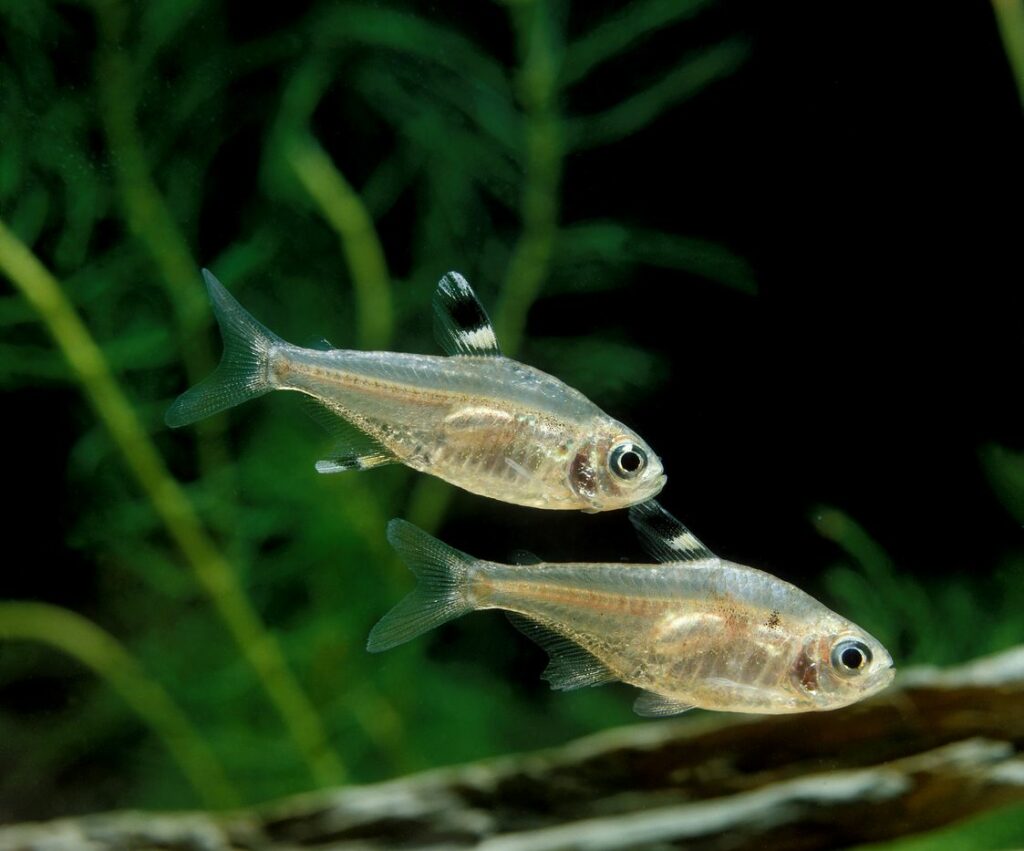
Breeding tetras is never an easy project but the x-ray tetras is as easy as these fish get. What is important is to get the water conditions as close to a neutral pH as possible while providing them with good food and plenty of places to spawn. And of course, you need to find them more of their own kind to choose mates from.
Pristella Tetra Male vs Female
In all tetra fish, the differences in the sexes are very subtle and hard to pick out. Almost all of them are not very sexually dimorphic, meaning it is hard to tell male from female just by looking. The pristella tetra is no different: both sexes are close to identical. Plus they tend to be chunky tetras to begin with.
Females will be a little chunkier than a male and when she has started to produce eggs, she will become even chunkier. But it’s never easy to sex these fish. They can tell each other apart by subtle visual and behavioral cues that we don’t notice. Fish also respond to hormonal cues in the water that help them tell each other apart.
The best way to have them breed is to have a large enough school where you will definitely have males and females.
Caring for Pristella Tetra Eggs
Assuming you have followed this guide to the letter, you will likely have a successful spawning. Pristella tetras are egg scatterers so they provide no parental care for their eggs or fry. They just drop them onto nearby plants and allow them to fend for themselves.
Unfortunately, these fish will forget about their eggs in a few hours and resort to eating them if you leave them in the same tank. So once the fish have spawned you should either move the fish or move the eggs to a new tank.
You can expect the 200 to 400 eggs to hatch within 48 hours. The fry are born with a heavy yolk sack that provides all of their nutrition for the first 1-2 days of life. After that they become free swimming and leave the bottom, looking for food. You will need to provide them with tiny live food at first by raising your own infusoria culture.
After the first couple of weeks they will then be large enough to eat baby brine shrimp nauplii and other small prey. You can also start weaning them onto powdered flake food at this point so they get used to prepared foods.
In Conclusion
X-ray fish are aquarium favorites for many good reasons. They are hardier than most tetras and you have a much better chance of breeding them successfully. Pristella tetras may not be as colorful as their cousins but they do have a unique charm all their own. And they look even better when kept in as large a group as you have space for.
More Frequently Asked Questions about X-Ray Fish
Still not done learning about x-ray fish? Then let’s dive into a few more questions about these little tetras.
Life expectancy for small fish is never a sure thing. But like most tetras, the x-ray fish tend to live between four and five years when well cared for with good food and clean water.
X-ray pristella tetra fish grow no larger than 2 inches. This makes them ideal residents for aquariums as small as 10 gallons. However, they do better in 20 gallon aquariums because they are very active and need to be kept in groups of at least 6 fish.
Pristella tetras are very hardy for tetra fish. They tolerate higher levels of nitrogenous waste and even low levels of salt. However you should still strive to provide them with top quality water, especially if you hope to breed them.

